10 Noteworthy LNG-Powered Vessels
LNG, termed as the fuel of the future, is also growing in popularity as a marine fuel. Studies have shown that LNG reduces Nitrogen Oxide (NOx) emissions by about 90 per cent while Sulphur Oxide (SOx) and particulates emissions are negligible. LNG engines also reduce CO2 emissions by 25 to 30 percent in general, compared to diesel or heavy fuel oil powered vessels.
With the present market value of LNG in commercially viable regions such as the US and Europe, LNG could be offered at a competitive price when compared to heavy fuel oil or HFO and even more attractive when compared to the low-sulphur gas oil, as fuel on ships.
Considering the importance of LNG as marine fuel, almost all major shipping companies have already launched LNG powered commercial vessels, while others are also preparing for the same.
Let’s take a look some of the important noteworthy LNG powered vessels which are either launched or under development.
1. Creole Spirit – World’s Most Efficient LNG Ship
Creole Spirit is Teekay’s first M-type, Electronically Controlled, Gas Injection (MEGI)-powered LNG vessel. The ship uses two stroke engine technology provided by MAN Diesel – the MEGI propulsion system which consumes only 100 tonnes of fuel consumption as opposed to the Dual Fuel Diesel Electric systems consuming 125-130 tonnes daily.
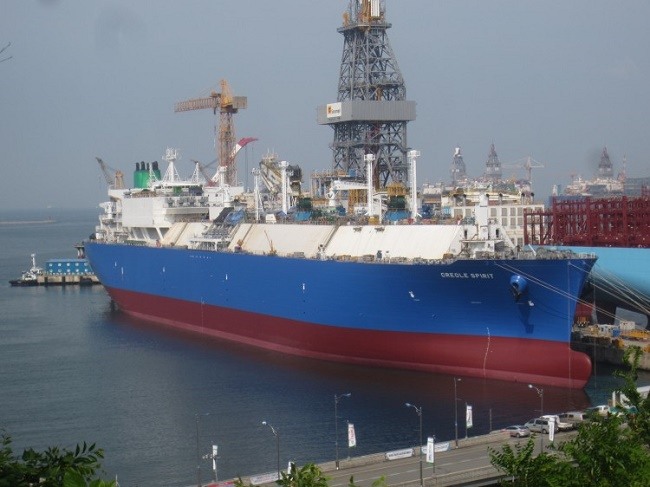
Apart from the engine, the reduction in the number of cylinders requiring overhaul, the reduction in the size of the complex electrical systems and the introduction of a passive partial reliquefaction system contribute towards improving the overall efficiency and reducing cost, making it world’s most efficient LNG ship with lowest unit freight cost.
Creole Spirit is on charter contract with Cheniere and is expected to enter service early 2016.
2. Isla Bella – World’s First LNG Powered Containership
Owned by TOTE, in partnership with General Dynamics NASSCO, Isla Bella proudly flaunts the title of World’s First LNG-powered Containership. She is also the first of two Marlin class containerships and the largest LNG-powered dry cargo ship.
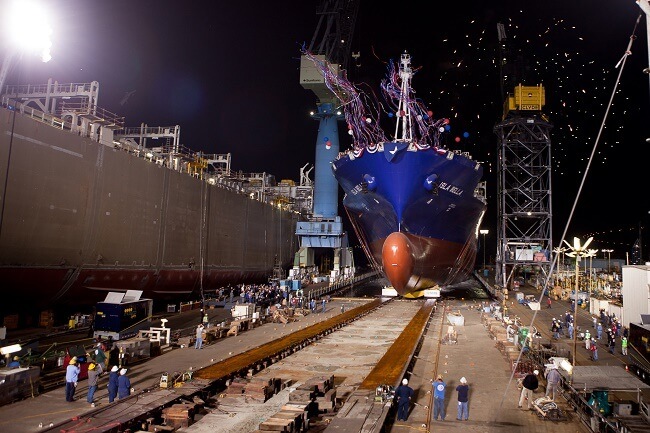
The Jones Act-qualified ship is equipped with Daewoo Shipbuilding & Marine Engineering (DSME)’s patented LNG fuel-gas system and is also the world’s first ship to be powered by a MAN ME-GI dual-fuel, slow-speed engine. This engines dramatically decrease NOx emissions by 98 percent, SOx by 97 percent, and carbon dioxide by 72%, making the ship the greenest vessel of its size. Not only does she feature a ballast water treatment system, but is also capable of burning diesel when needed, thereby further reducing the air-polluting emissions.
Isla Bella will soon be accompanied by her sister vessel Perla del Caribe, in first quarter of 2016.
3. World’s First LNG Powered Cruise Ships
Carnival Corporation has ordered four LNG-powered cruise ships, two of which would join the AIDA Cruises fleet. The construction will be carried out at Meyer Werft and Fincantieri S.p.A shipyards.
The four new ships will also feature a revolutionary “green cruising” design. The ships will be the first in the cruise industry to be powered at sea by Liquefied Natural Gas (LNG) — the world’s cleanest burning fossil fuel, representing a major environmental breakthrough.
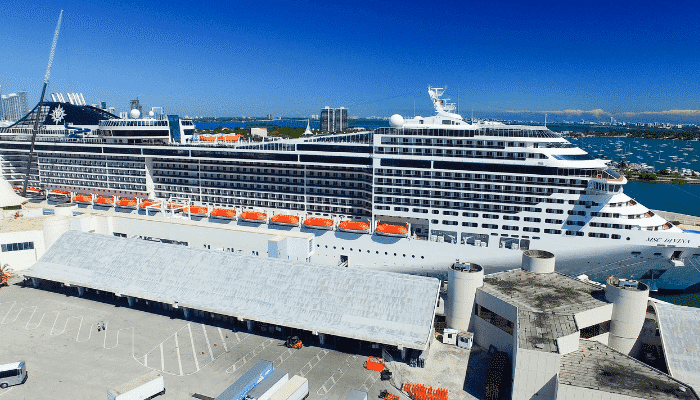
Based on Carnival Corporation’s innovative new ship design, each of the four next-generation ships will have a total capacity of 6,600 guests, feature more than 5,000 lower berths, exceed 180,000 gross tons and incorporate an extensive number of guest-friendly features. The ships will be the first in the cruise industry to use LNG in dual-powered hybrid engines to power the ship both in port and on the open sea. LNG will be stored onboard and used to generate 100 percent power at sea, producing another industry-first innovation for Carnival Corporation and its brands. Using LNG to power the ships in port and at sea will eliminate emissions of soot particles and sulfur oxides.
The expected delivery of these four cruise ships is between 2019-2022.
4. World’s Largest LNG Powered RORO Ferry
The world’s largest LNG Powered RORO Ferry has been ordered by Australian shipowner, SeaRoad and is under construction at Flensburger-Schiffbau-Gesellschaft (FSG) yard in Germany. At 181m, it will be the largest RoRo ferry with LNG propulsion and the first vessel of this type built by FSG. A comprehensive RoRo cargo access equipment package including two stern ramps/doors, one ramp cover, one access ramp and two pilot/bunker doors, along with installation services will be delivered by MacGregor, part of Cargotec.
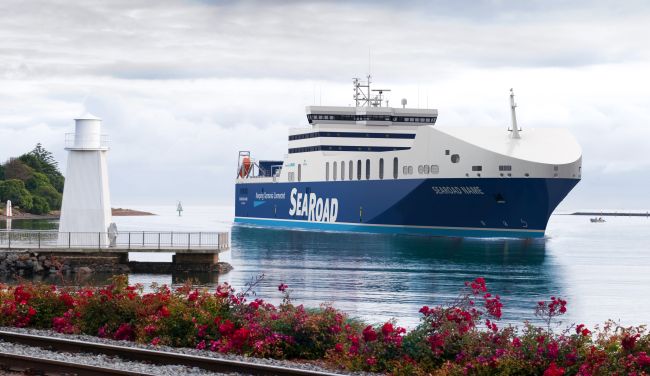
FSG says that the vessel will boast a particularly flexible cargo carrying capability and will be able to accommodate containers, including reefer units, trailers, cars and hazardous cargo as well as livestock. Delivery is scheduled for the third quarter of 2016.
5. Rem Eir – World’s Largest LNG Powered Platform Supply Vessel
Rem Eir, the world’s largest LNG powered vessel has been built at Kleven Vreft shipyard and is owned by Remøy Shipping. It has been Designed by Wärtsila Ship Design. With a length of 92.5 metres, breadth 20 meters, and a deck capacity of 1080 m2, Rem Eir is the world’s largest environmentally friendly LNG powered PSV. The vessel has entered in a long term chart with Statoil.
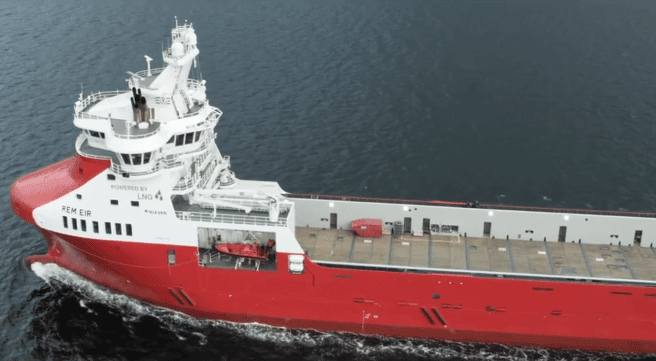
6. First LNG Powered Cement Carrier
The first unique LNG-powered cement carrier will be built at Ferus Smit shipyard for Erik Thun AB and will later be delivered to JT Cement. The vessels cargo system will consist of a fully automated cement loading and unloading system, based on fluidisation of cement by means of compressed air. The special fluidisation systems combined with slanted tank tops in the cargo holds will enable the bulk cargo to flow to a central suction point in the holds, from where it will be transported via pipelines.
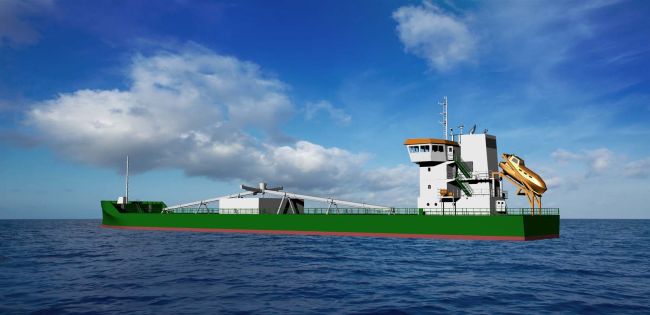
The cargo holds will be completely closed, identical to a tanker, ensuring environmentally friendly, dust free operation and possibility to load and discharge in all weather conditions. The cargo handling equipment will be able to discharge up to 500 m3 per hour. Cargo capacity will now be around 7200 DWT, with length 109.65m and breadth 14.99 mtr.
7. First LNG Powered ConRo Ships
Construction for the world’s first LNG-powered ConRo Ships began in October 2014. The ships’ Commitment class design is provided by Wartsila Ship Design in conjunction with Crowley subsidiary Jensen Maritime. They have been designed to maximize the carriage of 53-foot, 102-inch-wide containers, which offer the most cubic cargo capacity in the trade. The ships will be 219.5 meters long, 32.3 meters wide (beam), have a deep draft of 10 meters, and an approximate deadweight capacity of 26,500 metric tonnes. Cargo capacity will be approximately 2,400 TEUs (20-foot-equivalent-units), with additional space for nearly 400 vehicles in an enclosed Ro/Ro garage. The main propulsion and auxiliary engines will be fuelled by environmentally-friendly LNG.
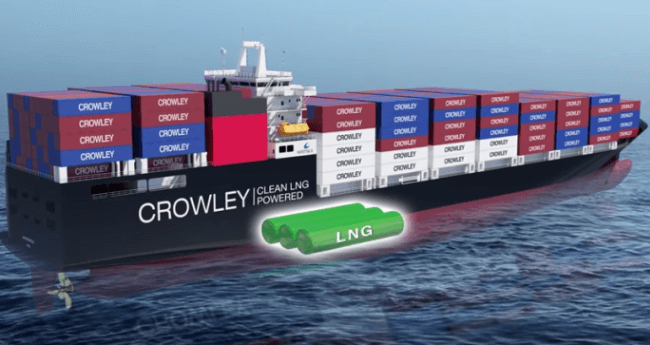
These new Jones Act compliant ships, which will be named El Coquí (ko-kee) and Taíno (tahy-noh) and will offer customers fast ocean transit times, while accommodating the company’s diverse equipment selection and cargo handling flexibility. El Coquí and Taíno are scheduled for delivery second and fourth quarter 2017 respectively.
8. World’s First LNG Fueled Drillship
World’s First LNG Fueled Drillship will be built at South Korea’s Daewoo Shipbuilding & Marine Engineering under joint development project (JDP) with ABS.
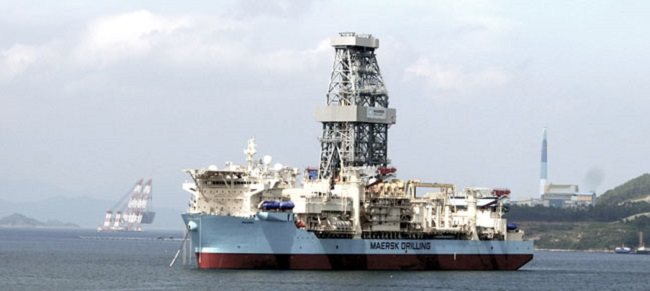
DSME has performed a concept design, comparison between two types of LNG storage tanks and analysis of the fuel gas supply system that will be installed on the drillship. ABS’ scope of work calls for concept design review, basic engineering review and a risk assessment of the tank space and access area, fuel gas supply system, machinery space and access area and associated configurations.
9. Scheldt River – World’s First Dual-Fueled Dredger
Scheldt River is a new generation “Antigoon” class dredger, being built by Royal IHC (IHC) in the Netherlands on behalf of the Belgium based DEME Group and will be powered by Wartsila Dual Fuel Engines. Operating on LNG allows DEME to set new standards in minimising harmful emissions. “Scheldt River” will easily comply with all local and international environmental regulations.
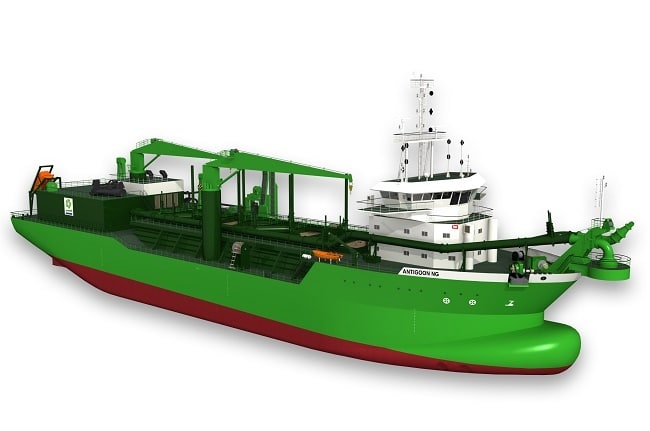
The 104 metre long vessel will have a hopper volume capacity of approximately 8,000 cubic metres. The scope of supply includes one 12-cylinder and one 9-cylinder Wärtsilä 34DF engines, two Wärtsilä controllable pitch propellers and two transverse thrusters as well as the company’s patented LNGPac gas supply and storage system.
Scheldt River will be the first ever dredger to operate on engines capable of utilising either liquefied natural gas (LNG) or conventional marine fuels.
10. World’s First High Speed LNG Fueled RoPax Ferry
World’s First High Speed LNG Fueled RoPax Ferry is being built for Swedish operator Rederi AB Gotland will be fuelled LNG and will feature Wärtsilä’s integrated solutions. By operating on LNG, the new 200 metre long ferry will comply with the International Maritime Organization’s (IMO) Tier III regulations regarding emissions of nitrogen oxides (NOx).
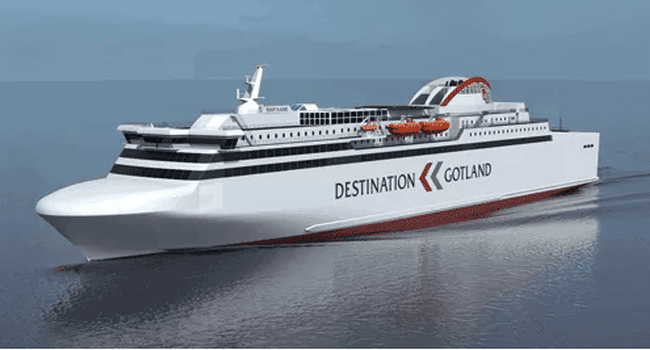
The ship will carry approximately 1650 passengers, will have 1750 trailer lane metres and can accommodate a corresponding number of passenger cars, campers and busses. It has been designed to meet the DNV-GL classification society’s high comfort ratings for climate, noise and vibrations.
Wärtsilä’s scope of responsibility includes four Wärtsilä 50DF dual-fuel engines, two gearboxes, two controllable pitch propellers (CPPs) with remote control system, two Energopac rudders, two tunnel thrusters, four Wärtsilä 20DF dual-fuel auxiliary generating sets, two Wärtsilä LNGPac fuel gas handling systems, gas valve units, a compact silencer system (CSS), an IMO approved Wärtsilä Aquarius UV ballast water management system, an Oily Water Separator together with a Bilge Water Guard to monitor and prevent oily water being discharged to the sea, project management services, integration engineering services, commissioning services and on-site supervision during installation. Delivery of the Wärtsilä equipment will begin at the end of 2015 and the ship is scheduled to be in operation in 2017.
Additional mention:
First Lng-Powered Tugs
The vessels, Borgøy and Bokn, are designed by the Norwegian tug owner Buksér og Berging AS and built by the Turkish yard Sanmar. These are the first tugs to be fuelled by the much more environmentally friendly liquefied natural gas (LNG) to eliminate sulphur emissions, bring particulate matter emissions down close to zero and reduce the discharge of CO2 and NOx by 26 per cent and 80-90 per cent respectively.

Powering each of the new tugs is a pair of lean-burn gas engines from Rolls-Royce Bergen, with a combined output of 3410kW at 1,000 rev/min. The engines are direct coupled to Rolls-Royce azimuthing Z-drives mounted aft in ASD configuration. The propellers have diameters of 3,000mm. The tugs are built to DNV Class including Fi-fi and oil recovery as well as escort notation. The tug has a length of 35 m, beam of 15 m and draft of 5.5 m with superior escort capabilities of 100 tonnes steering force at 1o knots. Static Bollard pull is 70 tonnes. For the ancillary tasks, where close quarter manoeuvrability is required, the vessels are fitted with a Schottel 333kw bow thruster whilst the main towing winch, suppplied by Karmoy, has a brake load capacity of 250 tons.
This is not an exhaustive list. If you know any other important LNG project that can be added to this list, let’s know in the comments below.LNG-Powered Fast Ferry
Do you have info to share with us ? Suggest a correction
About Author
Marine Insight News Network is a premier source for up-to-date, comprehensive, and insightful coverage of the maritime industry. Dedicated to offering the latest news, trends, and analyses in shipping, marine technology, regulations, and global maritime affairs, Marine Insight News Network prides itself on delivering accurate, engaging, and relevant information.

About Author
Marine Insight News Network is a premier source for up-to-date, comprehensive, and insightful coverage of the maritime industry. Dedicated to offering the latest news, trends, and analyses in shipping, marine technology, regulations, and global maritime affairs, Marine Insight News Network prides itself on delivering accurate, engaging, and relevant information.
Latest Marine Technology Articles You Would Like:
- 10 Harmful Effects Of Impure Air On Ship’s Machinery
- 10 Important Things to Check While Starting Fuel Oil Purifier on Ships
- 10 Noteworthy LNG-Powered Vessels
- 10 Points for Efficient Turbocharger Operation On Ships
- 10 Practical Tips to Handle Engine Room Pumps
- 10 Precautions to Take Before Operating Controllable Pitch Propeller (CPP) on Ships
Subscribe To Our Newsletters
By subscribing, you agree to our Privacy Policy and may receive occasional deal communications; you can unsubscribe anytime.
















I am intrested LNG propulsion engine.
I am a student of maritime. I am in need of maritime books.
dear sir
my name joginder singh .i am 1 year workingh iran port khuramsher . engion sid working as oiler.
any job rqurment plz i acpt job.
may whatsapp number +917009382927
Fjordline travelling between Norway and Denmark have been using LNG on their cruise ships for a long time:
https://www.fjordline.com/en/p/our-ships/ms-stavangerfjord
All information provided above is detailed and appropriate.
Look forward to learning more.
Big thanks!